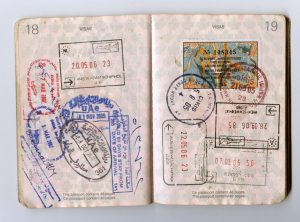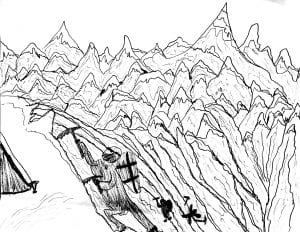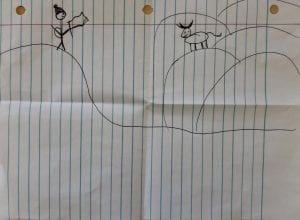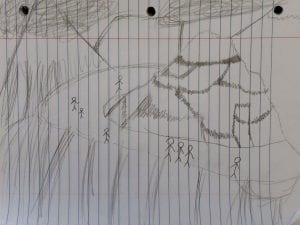Writing is such a mysterious art. As an adult, I still find it to be so. I have flashbacks to a high school composition teacher who never offered feedback on the creativity of a piece, but provided plenty of criticism on mechanics. Maybe it was then I concluded I could not write well.
In rebellion, or more accurately because it is good practice, I focus on writing as a process, where perfecting mechanics is just part of the final editing process, and where good storytelling is the most important thrust. Since many students get stuck when trying to write, feeling they don’t know where to start, or that their writing is stilted, or… I want them to embrace a “just do it” attitude. Each week, we (yes, that includes me) free write. I suggest that the students focus on some aspect of their semester-long writing project, but invite them to write about whatever they wish.

Writer, Writing, Paper, Letter, Author, Business, Text by Ramdlon is licensed under CC0 1.0 Universal (CC0 1.0)
To augment this idea of writing just to write, of allowing the imagination to wander, I recently had the students work in groups of three. Using a story starter, each group wrote a collaborative story in a shared Google document. The rules were pretty simple, they could not delete anything another student wrote (but could embellish the other students’ work), and they had 20 minutes to work.
The results were great fun (examples below, story starters in bold), and the students had a blast. I will use variations this activity on a regular basis!

Clorox Bleach products by Adina Firestone is licensed under CC 2.0 Generic (CC BY 2.0)
The harder she scratched away at her forearm, the quicker the flesh fell away. From outside the containment unit, Dr. Elana Miles and Dr. Mark Rustenburg watched in dismay as the young girl grimaced in discomfort as the virus ate through her skin like acid. Isabelle regretted drinking that bleach for a dare man her friends sucked so much she screamed in pain once more ‘I could have at least tried to make it taste better’ she thought sadly the doctors were still watching with confused looks on their faces as she continued to scratch and scream while rolling around on the floor . They had no idea that Basicly bleach™could do that to a person, especially since Basicly bleach™ is basic (like omg starbucks), not acidic. All the Basicly bleach™ ever wanted was a friend, but the Basicly bleach™ ate through Isabelle’s stomach just as quick as the Basicly bleach™ate through all of its other friends. “How many more friends must suffer!!??’ the Basicly bleach™ cried. The Basicly bleach™’s dad left when the Basicly bleach™ was young, and the Basicly bleach™ had been searching for a family and friends ever since, but life is hard for Basicly bleach™. Isabelle started screaming even louder which alarmed more doctors and soon the room was packed with doctors but none of them knew what to do suddenly Mojojojo walked thru the door with an antidote. One of the doctors said “quick use it!” and Mojojojo then looked at the doctors with the most evilest grin you would have ever seen and said “oh I’m not gonna use it!” and his smile became very large and wide and he drank the antidote and jumped out the window onto his pet eagle! But unfortunately the eagle was crushed under his weight, making his escape maneuver a total waste. Thankfully he had stored his backup elephant in the parking garage under the hospital It’s a good thing Duff duffman showed up then, as he regularly carried bleach antidote in his toolbelt (bc DUH). But being the clumsy oaf he is he tripped and stabbed himself on a charm from one of the nurses crocs (EVIL CROCS) Isabella was becoming more and more skinless as the hero failed to deliver an antidote withering in pain she became a puddle of acid on the ground. “We can still save her!” said one of the doctors “No, We tried all we could. She’s in peace now (eh kinda)” said Dr. Mark Rustenburg Isabelle’s grieving family scooped her up into a BIOHAZARD container and carried her home her friends were caught and arrested along with Mojojojo.
*no animals were harmed in the making of this story , well except the eagle he’s deader than a doorknob but hey the elephant’s ok still well kinda he was sold to Ringling brother circus and they mistreat their animals but he’s still alive and that’s the whole point*

plane sky clouds airplane travel flight trip by Rzh_edits is licensed under CC0 1.0 Universal (CC0 1.0)
When you are as rich as I am, it is easy to live an adventurous life. Just yesterday I took off on the company jet and went to Hong Kong. I had just gotten off when Madam Hoo, my cousin’s half sister’s older brother’s wife, grabbed my ear, she was a very short woman with silvery white hair and surprising strength for women far..far in her eighties. She said, “Oh Sonny boy, I never realized you’d visit me again! After that last visit…” she trailed off. Yes, that last visit was…strange to put it bluntly… I got banned from her favorite restaurant… and you’re gonna laugh because it’s so stupid and really I shouldn’t have been banned because it wasn’t my fault and I don’t know why it was a big deal…Because I tripped the waiter and spilled chicken and dumplings all over a customer’s face, who had just gotten up from a table after proposing to his girlfriend. The restaurant froze…The owner of the restaurant came out and told me and Madam Hoo to kindly leave and don’t come back. I boarded my plane home that same day. It’s their fault for using such cheap plates and waitresses/waiters on roller skates is such a gimmick! It isn’t the 50’s anymore!!
Madam Hoo shook her head. “It’s alright though. I’m not mad and I’m sure we’ll find another restaurant so you can spill the food on a waitress…” she meant it to be funny but I wasn’t laughing. Madam Hoo was a comedian back when the USO was huge, she wanted to turn her life around and stop sitting around, Madam Hoo loved traveling, so she knows about each and every country and the primary food they eat.. I smiled. “Yep.” Madam Hoo said back, “Alright, lets start your adventure!” For Madam Hoo’s age, she was a surprising blast of energy, I always loved her as a kid, and still do. We try to talk a lot, but it doesn’t work out sometimes, She is like a big sister. Even though she’s about 60 years older and I’m pretty sure 60 years is a big age difference for siblings, but it doesn’t matter, That’s what we always said. The first place she takes me is a weird clothing shop, It’s where everyone goes her age to find trends and stuff, they had emoji pillows and chairs shaped like hands and books the size of a fingernail, I was confused but Madam Hoo as usual was dazed and just so.. “Here!” She exclaimed “Look at this! Look at This! It’s Chinese Yuan! Have you seen it before?” “I had chinese yuan, because I couldn’t buy anything without it, I went to a shady currency exchange booth at the airport and the machine ate my money. I asked Airport Security to see if they could fix it, they did, Chinese Yuan’s conversion rate is terrible. I have 34K (5,000 USD) in Chinese Yuan in my wallet, which is a boatload, I figured you could never have enough especially for plane fares. I was shocked how cheap everything was, I never realized how different it was getting it from the source, Made In China never really made a difference, I wasn’t patriotic to anyone, So I didn’t care about buying Made In Somewhere not china. I told Madam Hoo, I was hungry, she was so excited, she was like, try this place it’s called “KFC”, I told her that was everywhere, nonetheless, we still went. They had extra spicy chicken that was not native to the US, I almost couldn’t take it! Madam Hoo smirked jokingly, “That’s what they all do”. The chicken tasted weird, It wasn’t rubbery like each and every other time I HAD to eat KFC, It was better, I was weirded out, I told her, “Chicken isn’t like this in the USA!” she replied, “Better, right?” I replied with a simple Yes. She said, “That’s because it’s geese meat!” I almost hurled, “I have to go to the bathroom”, you already know what happened next..

(passport pages 18-19) by Jon Rawlinson is licensed under CC 2.0 Generic (CC BY 2.0)
When they inspected Lesley Olson’s passport, she never expected they would let her through security so easily. The young woman had already prepared an arsenal of excuses to try to worm her way through. After a curt nod from the blue-eyed guard, she raced to join the flock of business-type sheep as they boarded their plane to London, England. It was going to be a long trip, made longer by her seating companions; one an over-perfumed woman with more Botox than personality and the other a loud, prematurely balding man in a cheap suit. The man spent more than half the time on the place complaining on his phone, while the woman made what could be a disgusted face if she still had the nerves left to do so. Lesley arrived in London 8 hours later, and not a moment too soon. Even though she was tired she had to stay alert. She was infamous enough to have half way across the world she had people who wanted her dead, ruthless fiends who would destroy everything in their way. It was her decision to move to London that probably saved her family. Nothing ever seemed to change, no matter where she was in the world. Weaving his way through the sea of people flooding the airport, the bald man had been moving ever closer to Lesley since they had disembarked from the gate. He watched Lesley closely, never letting her slip from his sight, and never getting too close lest he risk being noticed. Lesley was on edge, and had every right considering the past two weeks and quickly recognized that the man had the same blue eyes the guard had at the gate. Thinking of him more she realized they shared a facial structure, and it was at that moment that she felt her blood run cold. She was allowed on that plane for a reason. Exiting the airport and heading to her waiting cab, that reason climbed in beside her and gave her the most disgusting smile she’d ever seen. “Hey there.” he hissed in a voice more snake than man. It was then that he held up his phone and showed her the picture of her slaughtered family, with the news headline.
The prompts came from LetterPile, this list.












